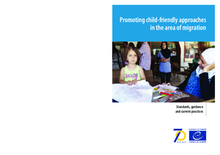Introduction
Since 2013, hundreds of thousands of children have arrived in Europe, many travelling unaccompanied and separated from their families. Although, the total number of children arriving decreased by almost 70% between 2016 and 2018, the number of unaccompanied and separated children increased by 31% during this period. Some countries received more children than others – but in Europe, Italy is known to have received the majority of refugee and migrant children.
Refugee and migrant children are highly vulnerable, more so without parental care. The level of vulnerability varies among boys and girls, and is especially acute among young children and adolescents. At the same time, refugee and migrant children may also display adaptive capacities and resilience in overcoming the hardship, difficulties and trauma they experienced in their home country, during the journey to a safer place and when integrating into the host community.
The Council of Europe has been concerned with the situation of refugees and migrants over many years and it has paid significant recent attention to the protection of refugee and migrant children. In particular, building on its human rights standards, in 2010, the Council of Europe Committee of Ministers adopted the Guidelines on child-friendly justice, recognising that “specific protection and assistance may need to be granted to more vulnerable children, such as migrant children, refugee and asylum-seeking children.” In 2016, the Secretary General of the Council of Europe identified a series of immediate priority actions to protect children affected by the refugee crisis and appointed a Special Representative on migration and refugees with a special mandate on the protection of refugee and migrant children. In 2017, based on the findings of the Special Representative of the Secretary General on migration and refugees the Committee of Ministers of the Council of Europe adopted an organisation-wide Action Plan on protecting refugee and migrant children in Europe (2017-19), with the purpose of improving children’s access to their rights and to child-friendly procedures, of providing children with effective protection from different forms of violence and of enhancing the integration of children who are to remain in Europe.
This compilation contributes to the implementation of the Action Plan objectives by bringing together international and European standards on child-friendly practices in the context of migration with illustrations from practice of the kind of initiatives, programmes and procedures that serve to implement these standards. It presents evidence that in most if not all areas of migration practice, international and European instruments exist to guide and inform how migration procedures promote children’s rights. In particular, the compilation addresses a wide range of issues, including the standards that must be applied to: the child’s registration and age determination, the child’s treatment in the migration decision-making process and measures that promote their rights – to protection, family care and to education. The compilation also highlights the imperative of finding a durable solution to what can often be a highly precarious situation for the child, whether accompanied or not, and makes clear that the child should be kept out of security or custodial settings while measures are taken to ensure that he/she is safely housed and provided with protection or is returned to their country of origin or resettled in their new home, after an appropriate assessment of the child’s best interests. What the compilation illustrates is the range and depth of standards currently set out in international and European law, both in European Union (EU) law and Council of Europe treaties and recommendations, and as set out it provides detailed guidance for states as to how best to promote child-friendly practices in the migration process.

